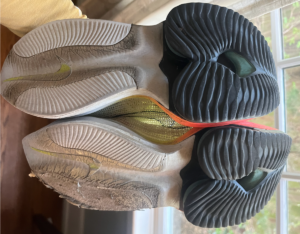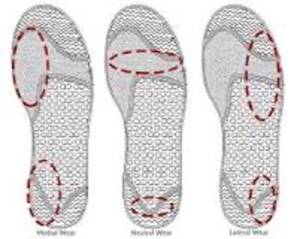I have a close running friend who is a running shoe expert. I sent her a photo of the soles of my racing shoes to see if she thought I had any miles left in them. She can tell this from the running shoe wear pattern on the soles of my shoes.
Instead of answering my question, she responded with concern. My right heel was worn away much more significantly than my left. To be fair, part of the sole of my Nike Alphafly had come unglued, causing it to wear more.

However, all of my running injuries have been on my right side. A hamstring tear on my right leg. A plantar fascia tear on my right foot. Compartment syndrome in my right quad.
Could my running shoe wear pattern be giving me clues as to why my right side kept getting injured? I wanted to find out, so I did research and got with Doctor of Physical Therapy Lisa Mitro.
In this article, I will answer:
- Why should you look at your running shoe wear pattern?
- The 3 basic running shoe wear patterns on the sole of a shoe & what they mean about your running form
- What does it mean if you have an asymmetrical wear pattern?
- Can running shoe wear patterns predict running injury?
- What should you do if you notice a pronounced running shoe wear pattern?
Related: What Are the Best Super Shoes?
Let’s roll!
Why should you look at your running shoe wear pattern?
Your shoe soles can hold clues to how you run, illuminating potential running form and mobility issues, muscle imbalances, and if you are wearing the right running shoe for you.
Indeed, looking at the soles of your shoes may help you prevent or treat running injuries.
How?
What the soles of your shoes can tell you:

The soles of your shoes have wear patterns where your feet regularly strike the ground.
“You are looking for more wear on the inside or outside of the bottom of the shoes. This gives you a little bit more insight into a running injury because it shows you where you are hitting the ground with the most force,” shares Mitro.
Ideally, you want the force to be distributed evenly along the foot and ankle during foot strike. If this isn’t the case it can give more insight into an overuse injury—or potential for one.
Looking at these shoe wear patterns can tell you information such as if:
- Overpronate (foot rolls into too much)
- Supinate (foot rolls out—less common)
- Have an imbalance (one foot strikes the ground harder than the other)
What the soles of your shoes CANNOT tell you:
Yes, your shoes can hold clues as to how you run aka your running gait. However, there are a gazillion variables that can impact your shoe wear pattern including different terrain, turns, shoe construction such as stiffness or heel drop, weather, the list goes on.
When you are looking at your shoe wear pattern, it’s important to look at multiple pairs of shoes and take these variables into consideration. Therefore, do not panic if you happen to see that your right shoe heel is completely eroded away while the other is perfectly intact.
Look for patterns in your shoe wear patterns. If you notice a trend, AND you are having injuries or noticeable gait issues (e.g. one leg feels stronger than the other), then these shoe clues may be able to help you unearth the cause of these problems.
Related: How to Fix Your Running Form
What do you look for on the soles of your shoes?
Take your running shoes and flip them over to examine the soles. Look for areas of wear including on the heels and outsoles. Also look at the toes including on the upper fabric. Look for asymmetrical wear patterns. Ideally, examine the wear patterns on multiple pairs of running shoes.
Related: When to Replace Your Running Shoes
Note that all runners will have wear patterns on their running shoes. Pronation is a natural part of your running gait to help absorb the impact of your foot slamming into the ground.
However, excessive wear on the inside or outside of your soles, or on one foot versus the other can be clues to recurring running injuries or predictors of future running injuries.
The 3 Basic Running Shoe Wear Patterns
Below are the 3 basic running shoe wear patterns on the sole of a shoe and what they mean about your running gait.
Medial Wear Pattern

A medial wear pattern on the bottom of your running shoe is seen on the insides of midfoot and heel, and is caused by your ankles rolling in upon impact, aka overpronation. Your ankles will naturally roll in for shock absorption and stabilization but many people’s roll into too much.
Overpronation may lead to running injuries such as plantar fasciitis, and knee and hip related injuries.
Related: Does PRP Help Heal a Plantar Fascia Tear
If you have signs of overpronation, don’t fret! You may just need a stability shoe or motion control shoe. Your best bet is to go to a running shoe store and have someone watch you run and make recommendations.
Neutral Wear Pattern
A neutral wear pattern is a normal wear pattern on the soles of your shoes and looks like an even wear in the middle of the ball and heel of your foot. This is the most energy efficient gait.
If you have this wear pattern, there is no need to tinker with your running shoes. Runners with a normal wear pattern should wear a neutral running shoe or minimal stability running shoe.
Related: Best Cushioned Running Shoe: Hoka Bondi 7 vs. 8 Review
Lateral Wear Pattern
A lateral wear pattern is the opposite of a medial wear pattern in that the shoe sole abrasion is seen on the outside of the forefoot and heel. A lateral wear pattern is a sign of supination (or underpronation) in which your foot rolls out instead of in on impact.
Supination in runners may lead to running injuries such as stress-fractures and joint injuries because your body isn’t absorbing the impact of your stride.
If you have signs of supination on the soles of your running shoe, you want to be in a cushioned running shoe (like Hokas!). Also, feel special—supination is rare!
Related: Hoka Rincon Review: Is the Rincon the Best Shoe for Plantar Fasciitis?
Why does my big toe make a hole in my shoes?
If your toe tends to always put a hole through the fabric on the top of the shoe, you may have what is called ‘hyperextension of the distal phalanx’. This means that instead of pushing down into the ground when you run, your big toe lifts and rubs against your shoe.
“Ideally you want your big toe to be pushing into the ground during push off and it stabilizes the arch and foot during foot strike. If the big toe is coming up, you are missing a big part of foot stability during the gait cycle,” says Mitro.
Big toe exercises to improve strength and mobility can help remedy this problem.
How do you know if you overpronate or underpronate?

You can tell if you overpronoate or underpronate by looking at the wear on the soles of your shoes. If your soles are worn away on the inside of the shoe soles, you overpronate. If your shoe soles are worn away on the outside, you underpronate aka supinate.
What is the difference between supinate and overpronate?
Supination is the opposite of pronation. Pronation is the inward rolling of the foot. Supination is an outward rolling of the foot.
What does it mean if you have an asymmetrical wear pattern?
Is it normal for shoes to wear unevenly? Yes. Most people have a dominant side of their body or asymmetries in their bodies like different length legs, so it is very common to have asymmetrical wear patterns on the bottoms of your feet.
Therefore, no need to panic if you have uneven wear patterns. However, if you are getting injuries on one side of the body, then it is prudent to have your gait analyzed and your body assessed by a physical therapist for imbalances.
Related: Strength Training for Runners Guide
Can running shoe wear patterns predict running injury?

So does an asymmetrical, medial, or lateral wear pattern mean automatic injury. No. There is no research that support that a shoe wear pattern can predict a running injury,
However, a running shoe wear pattern can give you clues to help solve current or chronic running injuries, improve your running efficiency, or (logic may assume) potentially prevent injuries in the future.
For example, if you’re an overpronator running in neutral shoes, then switching to a motion control shoe may prevent an injury down the line. Not to mention, changing running shoes may make you more comfortable!
Related: How to Predict, Prevent, & Treat Running Injuries on Your Own
What should you do if you notice a pronounced running shoe wear pattern?
According to Mitro, if you notice a pronounced running shoe wear pattern that is not a neutral wear pattern (or normal wear pattern), you should consider getting a gait analysis combined with an assessment from a physical therapist.
Related: 5-Minute Mobility Routine for Runners
A PT can tell you what weaknesses or limited mobility issues you may need to address. And don’t wait until you’re injured either.
Mitro says healthy runners may want to see a PT to see if there is anything that you could work on to prevent future injuries. Think of it as the same sort of maintenance you do for your car. This is an especially good idea if you are planning on ratcheting up your training.
Related: 7 Hamstring Exercises for Runners
If you don’t have a physical therapist, I recommend asking your running friends, calling a running store, or asking on a local running group or track club Facebook page for a recommendation.
If you want guidance with your run training, including strength training, check out my run coaching services. Also, be sure to check out my free training plans:
- Postpartum Training Plan
- After a Break Training Plan
- 5k Training Plans
- 10k Training Plans
- Half Marathon Training Plans
- Marathon Training Plans
- Strength Training Plan
